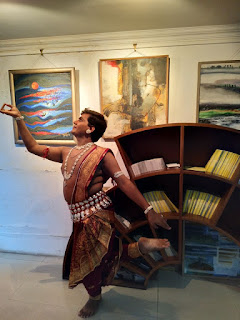Orissi -- Classical Dances of India Part 4
Error : This page is under maintenance
Orissi -- The classical dance forms of Oriya region
Orissi as the name suggests comes from the Oriya region or from the state of Orissa in modern India. Till the 1960s it was not considered as Classical dance, however Guru Smt. Sanjukta Panigrahi had gone down to south India and had extensively worked on the same to get this dance form a
 |
| Artist : Subhomita Maitra |
The antiquity of this dance form is evident from its roots that trace back to the ancient Sanskrit Hindu text called ‘Natya Shastra’ which deals with different performing arts.The history can be traced between 8th and the 11th century, when the kings took pride in excelling in art, music and dance. Quite a few stories about the King of Kaling and their patronage is famous.
While composing various dance items the choregraphers have used the statues of the ancient temples of Oria region as inspiration. The
 |
| Artist : Sunny Bhagat |
Reference to four popular styles of vrittis that is methods of expressive presentations namely ‘Odra-Magadhi’, ‘Panchali’, ‘Dakshinatya’ and
‘Avanti’ is found in the text, of which Odra refers to this performing art.Devadasi parampara is an important part of Orissi and so is the Gothipur Parampara.
 Costume : The dress worn in Orissi is sambhalpuri or katki saree of the region either in silk or cotton. The jewellery worn is intricate silver filigree. The word "Filigree" in french means " thin wire". In oriya it is called " TARCHASI". The ornaments used are Tikka, Allaka, Earrings (Jhummiki), Armlet, Neckless and Waist Belt.
Costume : The dress worn in Orissi is sambhalpuri or katki saree of the region either in silk or cotton. The jewellery worn is intricate silver filigree. The word "Filigree" in french means " thin wire". In oriya it is called " TARCHASI". The ornaments used are Tikka, Allaka, Earrings (Jhummiki), Armlet, Neckless and Waist Belt.Musical Instruments : The musical instruments that are
Traditions : There are 3 styles of Orissi dance that have evolved Mahari, Nartaki, Gotipu. The items includes Mangalacharan, Batu, Moksha, Pallavi, Slokam etc.
Noteable Dancers : Guru Deba Prasad Das, Guru Mayadhar Raut, Guru Pankaj Charan Das, Guru Mahadev Rout, Guru Raghu Dutta, Guru Kelucharan Mahapatra, Guru Sanjukta Panigrahi, Guru Sujata Mohapatra, Guru Reena Jana, Anindita Mukherjee, Dona Ganguly.

Note : Drop your queries or suggestions at
sangeetkalakendra1@gmail.com
Visit our Facebook page
: https://www.facebook.com/Sangeet-Kala-Kendra-1461430557205352/



Comments
Post a Comment